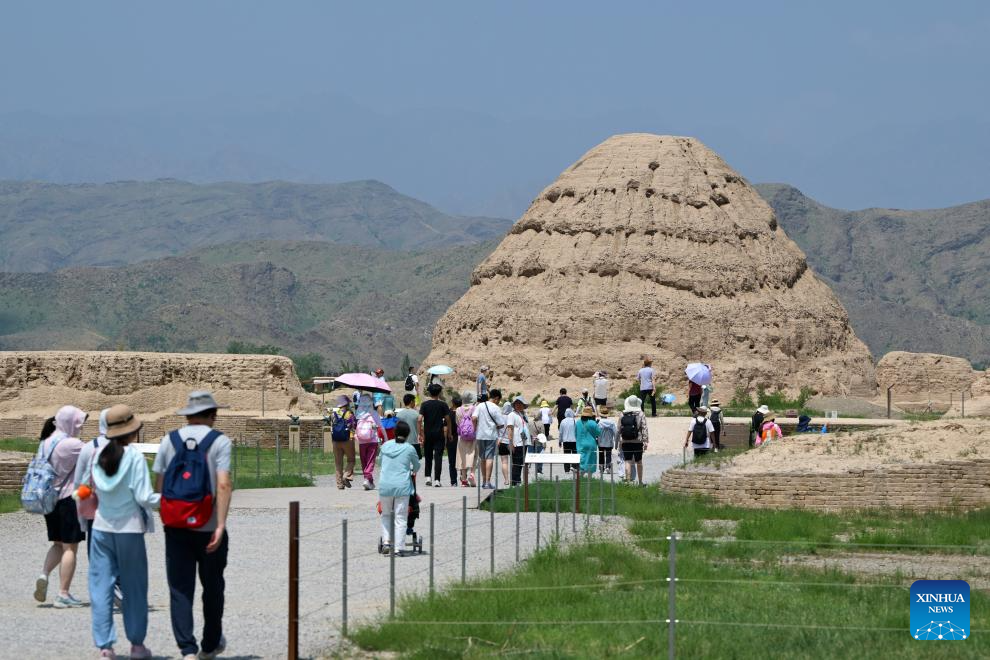Chinese archaeologists inspired by Xixia Imperial Tombs' World Heritage inscription

Tourists visit the Xixia Imperial Tombs archaeological site park in Yinchuan, northwest China's Ningxia Hui Autonomous Region, July 13, 2025. China's Xixia Imperial Tombs were officially added to the UNESCO World Heritage List on Friday during the 47th session of the World Heritage Committee held in Paris, France. (Photo by Yuan Hongyan/Xinhua)
Upon receiving the news that the Xixia Imperial Tombs have been inscribed on the World Heritage List, archaeological workers at the historical site of Yinxu in central China's Henan Province were overjoyed.
"We've always had high hopes for the Xixia Imperial Tombs' successful inscription on the list," said Yang Liying, deputy head of the Anyang Yinxu world cultural heritage protection and management committee in the city of Anyang, where Yinxu, or the Yin Ruins, are located.
She added that the Xixia Imperial Tombs' inscription on the list will help elevate China's status and influence in the realm of world cultural heritage preservation, and hoped that the two sites can engage in broader cooperation and exchange.
The 3,300-year-old Yin Ruins, confirmed as the capital site of the late Shang (Yin) Dynasty (1600 B.C.-1046 B.C.), was added to the World Heritage List in 2006 by UNESCO.
Now, nearly two decades later, the Xixia Imperial Tombs were inscribed on the list during UNESCO's 47th session of the World Heritage Committee held in Paris, France, on July 11. This has brought the total number of World Heritage sites in China to 60, nearly doubling the figure from 2006, when there were 33.
Located at the foot of Helan Mountain in Yinchuan, capital of Ningxia Hui Autonomous Region, the tombs were built by the Tangut, an ethnic group that thrived in northwest China between the 11th and 13th centuries. In 1038, the Tangut people founded the Xixia Dynasty, establishing its capital in what is now Yinchuan.
By analyzing the tombs' location, layout, architecture and artifacts, historians were able to see how the Xixia Dynasty adapted Han models during the Tang (618-907) and Song (960-1279) dynasties while infusing distinct ethnic features.
This evidence of ethnic integration is not unique to the Xixia tombs. It can be found in many of China's historical sites. According to Ji Tao, head of the Hailongtun cultural heritage management bureau in Zunyi, Guizhou Province, the tombs and the ancient ruins of Hailongtun Fortress share similarities in this regard.
"Both are important physical evidence of the development of a pluralistic yet integrated ethnic pattern in Chinese history, and both manifest the political wisdom of 'harmony without uniformity,'" said Ji.
In 2015, Hailongtun Fortress was added to the World Heritage List, along with two other historical sites. The three were jointly referred to as "Tusi Sites". They were deemed to "bear exceptional testimony" to the Tusi system, a chieftain system adopted by ancient Chinese central governments to unify national administration, while allowing ethnic minorities to retain their customs and way of life.
Apart from its historic and cultural value, the Xixia Imperial Tombs also illustrate China's multifaceted preservation of cultural heritage sites, said Liu Xiangyu, head of the cultural relics protection and management institute of Ji'an, northeast China's Jilin Province.
The protection work of the tombs is overseen by the cultural relics administration department of Yinchuan Municipal People's Government. Meanwhile, departments of city planning, land and resources, as well as housing and urban-rural development all work in coordination within their respective duties, forming a joint force for protection.
According to Liu, this tiered and coordinated system of historical site preservation was also adopted in the protection of the Capital Cities and Tombs of the Ancient Koguryo Kingdom in Jilin, which was inscribed on the World Heritage List in 2004. "As heritages of the same type, the two sites share many similarities in terms of protection methods," Liu said.
With its World Heritage inscription, the Xixia Imperial Tombs have now gained a new opportunity to inspire archaeological workers in China and the Chinese people as a whole. The head of the Xixia tomb area management office has vowed to take the inscription as an opportunity to comprehensively and continuously explore the cultural value of the site, and spare no effort in advancing its systematic protection, utilization and research.
Web editors: Shen Jianqi, Li Siyao
